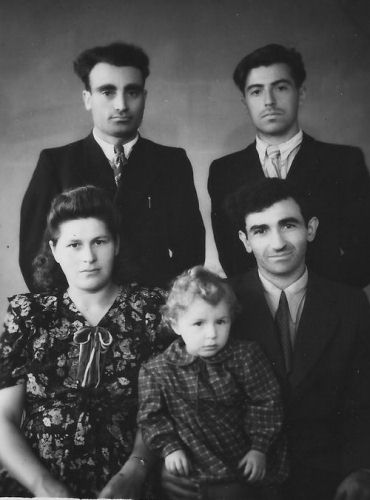
|
Seated:Zelig Yoffe with his wife Ida and their daughter Chanale
|
At Zarasai a Lithuanian took me with him on his wagon and we rode to Dusiat.
We arrived at the outskirts of the shtetl late at night. I went to the home of Sakalis, a Lithuanian who used to work with my father. Sakalis was a family friend who even spoke Yiddish ... He recognized me immediately, and even reminded me of how I used to ask him in Yiddish to give me horseback rides: “Vi a ferdele (like a pony),” he mimicked my voice. Years later when his daughter was studying in Vilna (Vilnius), she resided with me.
That night I was told about the fate of my family and the other members of the shtetl. The Germans had entered the shtetl on June 25th or 26th. My sister Golda managed to escape to the nearby village, and hid in the home of Dushke, a Russian woman who used to work in Jewish homes in the shtetl. But Golda disappeared and nobody has any idea of what happened to her. My parents were evicted from their home, and went to stay outside the shtetl at the home of Pashunas, the Goy. My father continued working as a blacksmith. Then one day they round up all the Jewish residents of Dusiat and concentrated everyone together in several homes in the area beyond the bridge - Unter dem Brik. Every day they sent groups of Jews to clean the sidewalks and do all types of other despised jobs, while at the same time hurling abuse at them. I heard one story about a Lithuanian woman, Blinkienye (may her name be blotted out!), who pulled off the women's earrings together with the flesh of their earlobes! After the war she went to live with her daughter who had married a Jew...
I was told that the Lithuanians wanted both my father and Dr. Epstein to remain in the shtetl, since their work was extremely useful. However, the Germans ordered otherwise.
On the morning of that fateful day [August 26, 1941], they deceived the Jews and told them they were going to be transported to work somewhere else ... I heard about the Jewish doctor from Salok (Salakas) who did escape at this point but eventually got caught. He was tied to a horse and dragged all the way to the pit ... I was also told about Elke Barron who managed to escape the field of slaughter and who hid in the forest for three years. Alas, right before liberation he drowned in the lake …
I heard about the fate of my Uncle Tode Burstein, who was a blacksmith in Dusiat and was known as a hero. The Goyim were afraid of him because he had given quite a few of them a good beating. The story goes that when the war broke out, the Lithuanians got hold of him and shot him several times until he gasped his last breath...
I found Dusiat completely devoid of Jews. The local and neighboring Lithuanians had taken over the houses, and Russians were living in our home. They invited me to stay overnight, but when I entered the bedroom and saw my parents' bed made up, I couldn't bear it anymore, and immediately took off.
I walked along the street, and do not recall seeing the synagogue (Beit Hamidrash).
The Monument to the Unknown Soldier which stood in the market square at the center of the shtetl and which symbolized Lithuanian independence had been destroyed...
As I walked along the street, Lithuanians watched me in awe as if I had been resurrected...
I wanted to take revenge, to punish the oppressor. They told me that Gailusas was alive. At the police center in Vilna I told them about the terrible things he had done, but was informed that he had already received his due punishment.
It came to my attention that Repsis was working in a sovhoz (State farm) as a technical manager in a plant that manufactured bottles. I convinced a Lithuanian to complain about the fact that the criminal Repsis was holding a higher position than his own (apparently Repsis' brother was also a murderer), and indeed, not long afterwards that oppressor was transferred to manual labor. More than once our gazes met in the street. Once, when I noticed he was completely drunk, I almost jumped on him with the intention of killing him.
In November 1972 I made aliya to Israel with my wife Ida and my daughter Mira. I immediately began working at anything I was able to get. We received a small apartment in Netanya, and in our tiny garden my daughter Chana, who was visiting from Russia, planted a seedling that grew into a tree.
She always asks in her letters: “How is my tree doing?”
|
|
Seated:Zelig Yoffe with his wife Ida and their daughter Chanale |
|
|
The Survivors beside the Monument in the Deguciai Forest On the left: Etka (Yossman) Kulvelis, Zamke Glezer Seated: Ida Yoffe, Luba Napoleon, sisters Chanale (in front) and Mirale Yoffe, Luda (Etka's daughter) and Ida Glezer (Zamke's daughter) |
|
|
| At the Yizkor Book Launch, Tel Aviv, October 15, 1989
Zelig Yoffe looking at each house on “The Face of the Shtetl” |
|
JewishGen, Inc. makes no representations regarding the accuracy of
the translation. The reader may wish to refer to the original material
for verification.
JewishGen is not responsible for inaccuracies or omissions in the original work and cannot rewrite or edit the text to correct inaccuracies and/or omissions.
Our mission is to produce a translation of the original work and we cannot verify the accuracy of statements or alter facts cited.
 Dusetos, Lithuania
Dusetos, Lithuania
 Yizkor Book Project
Yizkor Book Project
 JewishGen Home Page
JewishGen Home Page
Copyright © 1999-2026 by JewishGen, Inc.
Updated 29 Aug 2009 by LA